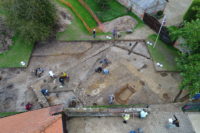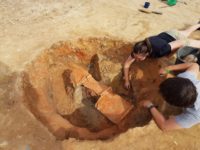 Archaeologists excavating near the village of Silchester in Hampshire have unearthed the remains of a Roman temple, the third discovered to date in the town.
Archaeologists excavating near the village of Silchester in Hampshire have unearthed the remains of a Roman temple, the third discovered to date in the town.
Known in Roman times as Calleva Atrebatum after the Atrebates tribe who founded the town in the 1st century B.C., it was first an autonomous ally of Rome. It was an oppidum, a fortified settlement, which appears to have largely functioned as an independent city-state under a series of rulers. The first of these and the city founder was Commius, a Gallic chieftain who had aided Julius Caesar’s veni, vidi, vicing in Gaul before becoming switching sides to Vercingetorix and ultimately cutting a deal with Mark Anthony in which Antonius guaranteed Commius would never have to see a Roman again if he took his annoying crew across the Channel and stayed there for good. Coins have been found in Silchester with Commius’ name, so it seems he followed through and was indeed left alone.
A hundred years later times had changed. Now the Romans were interested. One Roman in particular. Specifically the biggest Roman kahuna of them all: the Emperor Nero. He bought Calleva, land, buildings, lock, stock and barrel, as his personal property. He seems to have taken the town as a kind of pet project, endowing it with major public buildings and converting the Atrebates settlement into a symbol of Roman industry, splendour and powder. Perhaps it was carrot, perhaps it was stick, probably a little of both, but he wanted his subjects way up at the perimeter of empire to feel his (and Rome’s) reach keenly. With imperial moneys flowing in for construction, the new city became a hive of proper Roman industry. Lots of new trades, lots of temples and other civic structures.
 University of Reading archaeologists have been excavating in Silchester for years, always hoping to find a little Nero under the next shovel-full of soil. Two years ago they found a two-letter inscription and even that meagre material (albeit very cool because it was the second fragment of an inscription whose first fragment had been discovered in 1891) was enough to give them hope they might find Nero’s name somewhere. They didn’t that time, but this time they sure have.
University of Reading archaeologists have been excavating in Silchester for years, always hoping to find a little Nero under the next shovel-full of soil. Two years ago they found a two-letter inscription and even that meagre material (albeit very cool because it was the second fragment of an inscription whose first fragment had been discovered in 1891) was enough to give them hope they might find Nero’s name somewhere. They didn’t that time, but this time they sure have.
The temple remains were found within the grounds of The Old Manor House in the Roman town at Silchester, along with rare bricks stamped with the name of the emperor, who ruled AD54-68.
Professor Michael Fulford CBE said: “The stamped bricks we’ve found were made just south from Silchester at a place called ‘Little London’.
“They were stamped to show the Emperor’s ownership of what was being built there, and are quite unique to Silchester.
“The stamping of Nero’s name on the bricks essentially acted like a batch marker.”
Four fragments of the bricks were found in a ritual pit within the temple site – the largest concentration ever found in the town – along with another three at the kiln site which made the tiles in Little London.
“These findings are a crucial piece of the jigsaw as we look to solve the mystery of Nero’s links to Silchester. This is something that has puzzled archaeologists for more than a century.
“Only a handful of Nero-stamped tiles have ever been found in the UK, so to unearth this many was very exciting.”
No references to specific deities have been found that would explain which temple this one, or which gods the other two temples were dedicated to. Fulford speculates that if there were only three temples total, they could each have been dedicated to the central triad of Jupiter, Juno and Minerva which was a common combination. There is no hard physical evidence either way.